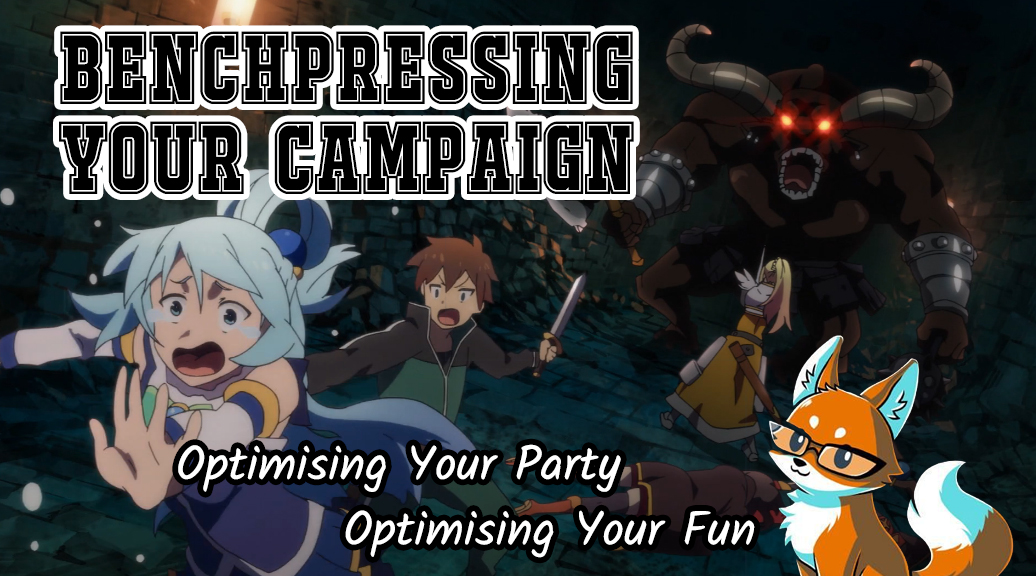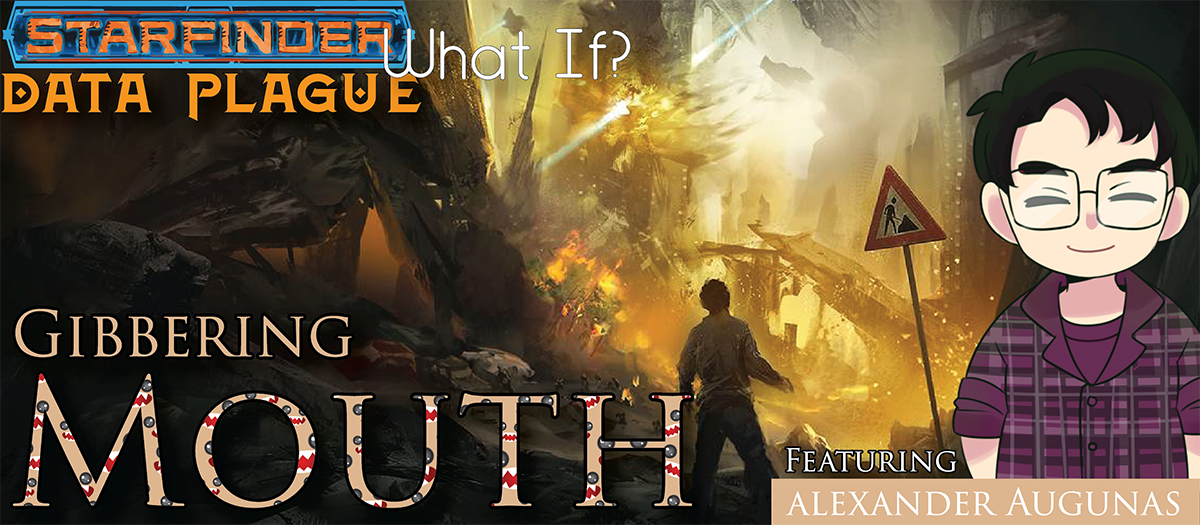No two PCs are alike. No two parties are the same. Optimization is a tricky subject to write about, especially when your game has as much content as Pathfinder First Edition. If you are looking for guidance as a player, I recommend checking out a video by Mark Seifter and Linda Zayas-Palmer on Arcane Mark. But this article is a look at bench-pressing for Game Masters, and the importance of planning out your campaign’s benchmarks before your first adventure. This is especially important in Adventure Paths, which are generally designed for parties with an “average power level”, but even if you’re playing in a completely custom setting, this is advice I would give any GM.
You might wonder what I mean by “bench-pressing”. You can read the entire article on RPG Willikers on analyzing a character’s build level by level. But the easiest way to define it? Benchmarking is comparing a character’s stats with monsters and hazards that character is likely to face. Pathfinder gives us this super handy Monsters Statistics by CR chart. You can use that to play out the odds of a character surviving or defeating a threat. And while plotting out every statistic can be a burdensome task, doing it for just a few key levels in your adventure will make sure the entire party is relatively balanced.
Proper Party Balance Means More Options For Everyone. Have you ever considered letting a PC play a Centaur? Probably not when you look at those stats. But I ran this test on a Centaur Sanguine Angel and a Human Zen Archer, and guess what? Almost the same HP & AC, but the Centaur was blown out of the water on saving throws and damage per round. They even had the same movement speed by level 6! Now maybe the Sanguine Archer Build is just “bad”, but I’d argue that by banning a more powerful race like Centaur you are indirectly limiting characters from using suboptimal options like the Sanguine Angel. Not all PCs are the same, and there is nothing wrong with limiting which options can be combined on a case-by-case basis if your players understand from the beginning that this step is necessary to keep a campaign engaging.
This Isn’t (All) About Party Balance. This is about keeping the narrative of a campaign engaging. Yes, you can add templates to every encounter hoping to keep your players on their toes, but that runs the risk of ruining the morale of players whose characters are inspired by less optimal mechanics. No one is going to have a good time one-shoting every enemy. Likewise, no one is going to enjoy knowing their favorite class feature only has a 10% chance of success. But even if you are running a completely custom campaign Bench-Pressing is an invaluable tool.
Balance Isn’t For Everyone. I’ve seen parties where one character can solo an entire campaign, and the rest of the table didn’t mind. Some tables want to dominate every encounter without a threat of death. Others want to barely scrape past each encounter as though they were trying to do an entire run of Pokémon using only a Luvdisc. You have to know what motivates your players to play, perhaps even running a shorter module or Pathfinder Society scenario to get to understand what they want out of a game. Once you understand the kind of campaign your players want, you can begin your “session zero” character creation.
Many players do not like “planning out” their character’s builds. But asking your players where they think they will be going, without setting anything in stone, can give you an idea of where your players are going. Does Bob want to play a Paladin? Great. Is he using an Archetype? Prestige Class? Any feat-trees he’s considering? You don’t have to determine in advance which character options are legal and which are banned…you only have four to six characters at your table! Figure out what they want to play during Session 0 and inform them that you are going to “look into” all of their potential characters. Make sure they understand what you’re doing and why; Make sure you understand that you are taking an objective and scientific approach to party balance. If a majority of your players aren’t sure that a character concept will work, you can even play out the first session to get the wheels greased. But make sure they understand that you will be checking out their classes and concepts to make sure everything is balanced.
The Process
If your players want to plan out their characters for you, you can skip steps 1 & 2.
Step 1: Build the Characters
Now take those characters and level them. I recommend hitting levels 6 & 11, but it largely depends on where you expect your campaign will end. You should have their ability scores, class and race by now, and if your players aren’t going to pick a line of feats you’re expecting they probably should plan it out in advance and run it past you anyway. Just make a quick sheet with the necessary stat’s for that PC based on its primary role in the party. Include AC, Hit Points and Saving Throws for everyone.
Step 2: Estimate Additional Factors
Account for the buffs your party is most likely to use (and if they plan on using it on others)! Ask your party who might pick up some support spells, especially wands. Usually, you can assume +2.5 to hit/damage/saves and +3.5 to AC per support caster. And once you hit level 6, you should assume “Haste” will be active, given it’s one of the most powerful spells in the game.
Don’t forget to account for gear! You can find Character Wealth By Level by using ctrl+f on that page, and use it to assume the character is properly equipped with magic weapons, armor, cloaks of resistance, and other basic stat-boosting items. At level 6, a PC should have 16,000 gp but will have slightly more in most APs. I like to assume they’ll have a +2 Weapon, +2 Armor, +2 “Ability” Belt/Headband and a +1 Cloak of Resistance. Casters will likely have some way to increase their Caster Level by 1 for their favorite spells, and a handful of wands and scrolls.
Step 3: The Actual (Combat) Bench-Press!
Now it’s time to return to your handy-dandy Monster Creation rules! Make yourself a simple spreadsheet and write out your PCs DPR*, AC, HP, Saves and ability DCs at a specific level. Compare each to the monster’s HP, High Attack, Average Damage, Primary Ability DC and Good Saves. You can use this spiffy chart by Derklord. Take a minute to consider each and how they measure up to a threat of their level. Remember critical successes and failures, and check your percentiles. Is it okay that a monster can be debilitated by a PC 50% of the time? Is it okay that your PC’s primary ability will only work 20% of the time? Consider how difficult the campaign should be for your players, and make sure your players can at least fulfill their most basic roles in the party better than a member of the party filling another role. Don’t forget to consider common creature types, immunities and the theme of your campaign.
The expected damage value is the most tricky thing to calculate here. Fortunately, you only need to calculate it for dedicated damage dealers. Take the character’s attack modifier and compare it to the monster’s AC. Figure out the hit percentage on a d20, ignoring critical hits. Multiply that by the average damage. Then take the odds your attack will be a critical hit and multiply that by the damage you do on a critical hit. Add them together, and you get your “expected damage value”. Remember multiple attacks and haste!
Step 4: But Can They Pay the Bills?
Skills are one of the most difficult factors when determining party balance. It’s important that you, as a GM, determine which players are most likely to do which skill checks. Many players are comfortable excelling in non-combat encounters at the expense of combat efficacy, and you should make sure the rest of the group is okay with that. This will heavily vary from campaign to campaign, as War for the Crown naturally has more opportunities for these skillful characters than Shattered Star. You can get a general idea of good skill DCs from this chart by Run a Game, but sometimes it’s best to just check some out of combat encounters at that tier and get a “feel” for the different DCs.
Step 5: Adjusting
This is the most important step, and one of the must difficult. The more you know your players, the better you can adjust party balance. Some GMs like to adjust treasure to help balance out a party, even giving out relics or artifacts in forms that compliment certain characters without fully revealing their power. Other won’t mind just blatantly adjusting what certain characters have access to, using optional subsystems like Stamina from Pathfinder Unchained, or opening access to rare options like Azlanti Pureblood Humans. Many times simple, even PFS legal adjustments can be made to existing concepts to bring them in line with the rest of the party. Certain Prestige Classes becomes considerably better if you figure out creative ways to bypass oppressive prerequisites or let them count for favored class bonuses, and I doubt many optimized summoners are going to care if the party’s Lion Blade got an ioun stone that grants the Deceitful feat. Just make sure everyone in advance understands and agrees that there are going to be opportunities for adjustments as the game goes on. Certain options may be limited to certain characters, and never forget The Most Important Rule.
Conclusion
Now you might write this off as paranoia, but I’ve done benchmarks of my PCs for Pathfinder Society and let me tell you it was eye opening. Just having a chair at the table makes you an asset, and one more experienced player can make all the difference, even if they are just a disembodied voice reminding the rogue to check the door before going into the next room. But when the difference between two dedicated damage dealers is 74.825 damage or 145.45 damage per round, it can be absolutely demoralizing for both the GM and the PCs when you learn the second character also has more than double the skill points of the other PC! Balancing a party is not about “power shaming”. On the contrary, many of us tweak our characters because we are afraid of stealing the spotlight. Having a GM as an arbiter who is willing to sit down and help us is a blessing. After all, you can invest months into a campaign. With that in mind, what’s a couple of hours?





